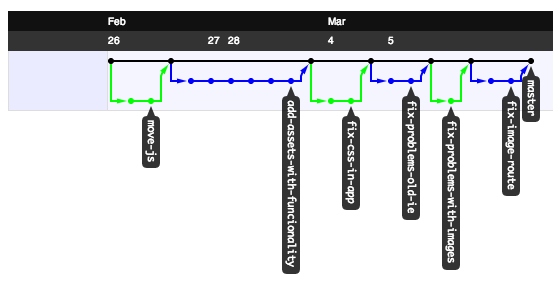One day I was reading Hacker News when I stopped in a gist named a simple git branching model by Juan Batiz-Benet. After sending it to The Amazing Dev Team we started discussing how to have a simple, clean and semantic branching model.
After a few conversations during these months, we decided to write it down to specify the rules and why they work for us.
The Rules
mastermust always be deployable- all changes should be made using feature branches (merging with
master) - all hotfixes should be made in the
hotfixes-{name} - rebase to avoid/resolve conflicts; merge into
master
The explanation
mastermust always be deployable
We deploymasterwhen pushing to origin. We do this using Jenkins and Continuous Integration.- all changes should be made using feature branches (merging with
master)
This way branches have more meaning in a semantic way. Each branch is a feature of the project and the code can easily be found. - all hotfixes should be made in the
hotfixes-{name}branches
When lauching an application you receive a lot of feedback, specially if you have more than 9 million readers a month. This feedback sometimes is a new feature or sometimes is a quick and hot fix that should be deployed immediately. One optimization to this step is creating a hotfixes branch every release and deploy it to production, this way you will keep the master clean and you have a fast response time. - rebase to avoid/resolve conflicts; merge in to
master
Please avoid the merge bubbles. Please.
#Some Code To Understand
# First, create a new branch from master.
$ git pull origin master
$ git checkout -b new-feature
# Make changes and commits.
$ git add .
$ git commit -m "Changes"
# When finishing the new feature you should bring the code inside master to the branch.
# It's a good practice to make it frequently during the development of the feature.
$ git fetch origin master
$ git rebase origin/master
$ git push origin new-feature
# Sometimes, when there are conflits at rebasing, you should make git push -f origin new-feature.
# After finishing, you should merge and push the new features to master.
$ git checkout master
$ git pull origin master
$ git merge --no-ff new-feature
$ git push origin master
The importance of --no-ff flags when merging is huge, because it prevents a “fast forward” constructing a commit for the merge. You can read more information in this post.
The results
If you follow this methodology you can transform this merge chaos:

Into this beautiful git pipeline:

Feel free to send feedback!
